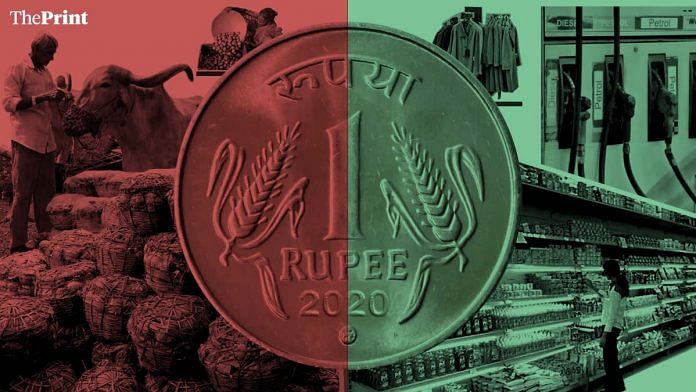The headline inflation for the month of June stood at 6.09 per cent, slightly above the RBI’s target range of 4 per cent plus/minus 2 per cent. This is the key data point that the Monetary Policy Committee will consider when deciding about the policy rate in its next meeting, scheduled early next month.
While inflation outside the target band would warrant an interest rate hike in normal circumstances, the details show that a hike is not warranted.
A persistent and generalised price rise would lead to a decision to hike interest rates by the RBI. The June inflation does not reflect a generalised price rise. The increase in prices seen in some segments of the Consumer Price Index (CPI) seems to be largely on account of supply-side disruptions. These may be expected to be temporary.
Also read: Inflation could surge to 12% if RBI starts printing money to fund govt, Rabobank says
Rural vs urban inflation
While the rural headline inflation inched up to 6.20 per cent in June from 6.18 per cent in May, urban inflation declined to 5.9 per cent from 6.43 per cent in the same period.
Over the last three months, the overall inflation has largely been driven by food inflation. Even though the contribution of food to the overall inflation declined in May and June as disruption in supply chains eased, roughly two-thirds of the overall inflation is still driven by food. Inflation in food fell to 7.29 per cent in June from 8.37 per cent in May. The decline in food inflation was visible across rural and urban segments. With a good monsoon and satisfactory sowing of Kharif crop, food inflation is likely to decline further in the coming months.
In June the categories of inflation that showed an increase were clothing and footwear; paan, tobacco and intoxicants; and miscellaneous items. In all three categories, the increase was seen in the countryside, while the urban India showed a decline.
Inflation in paan, tobacco and intoxicants for rural India jumped to 9.93 per cent in June from 4.84 per cent in May. For urban areas, it showed a decline to 9.12 per cent from 10.35 per cent. In the clothing and footwear category, also we saw a similar trend — while rural inflation inched up, urban inflation declined. In the miscellaneous category, while the combined inflation declined from May to June, rural inflation showed an increase to 5.3 per cent from 4.41 per cent. Urban miscellaneous inflation declined to 6.14 per cent from 7.28 per cent. The increase in miscellaneous inflation was largely on account of increase in costs of transport and communication, which again could be an outcome of the lockdown.
Core inflation is another indicator of inflation in India — it captures inflation excluding food and fuel. Core inflation increased to 5.05 per cent in June from 4.9 per cent in May, and while urban core inflation fell to 4.98 per cent from 5.7 per cent, in rural areas it jumped to 5.1 per cent from 3.8 per cent.
Also read: This recession is different & India can bounce back much faster than in the past
Quality of inflation data
Another issue relates to the quality of inflation data during the lockdown, due to difficulties in data collection.
The Central Statistical Office released the June headline inflation data after a gap of two months as, in April and May, field enumerators could not visit specified outlets to collect price quotations. Transaction of products was also limited in the months of April and May, so prices of some sub-groups were not available.
The note released by the CSO mentioned that, of the 23 sub-groups, the indices of 13 sub-groups in April and 15 sub-groups in May were compiled. With limited data, it was not possible to construct state-level indices, as well as the all-India General CPI.
To address the issue of missing data, the CSO released an imputed index for April and May along with the June data. The inflation index for the sub-groups for which data was not available was also imputed. The imputation methodology draws from the ‘Business Continuity Guidelines’ brought out by Inter-Secretariat Working Group on Price Statistics.
However, sharp swings in prices of some sub-groups such as paan, tobacco and intoxicants have raised doubts on the credibility of the imputation methodology.
Also read: Credibility of India’s statistics back in question over official inflation data
Supply-side disruptions
While indicators show a slump in demand, the rise in inflation appears to be an outcome of supply-side disruptions. Trends show that the problem of supply-side chain disruption and fewer collection centres was more acute in rural areas.
With gradual resumption of supply chains, inflation may be expected to see a downward trend in the coming months. The limited data collection and doubts on the imputation methodology also suggest that it would be appropriate for the RBI’s MPC to wait for more data points to arrive at a decision about interest rate changes.
Ila Patnaik is an economist and a professor at National Institute of Public Finance and Policy.
Radhika Pandey is a consultant at NIPFP.
Views are personal.
Also read: How Modi govt’s ordinance on cooperative banks can prevent PMC-like scams, protect depositors




So are we moving towards a stagflation situation??
However, cutting them is no longer an option.